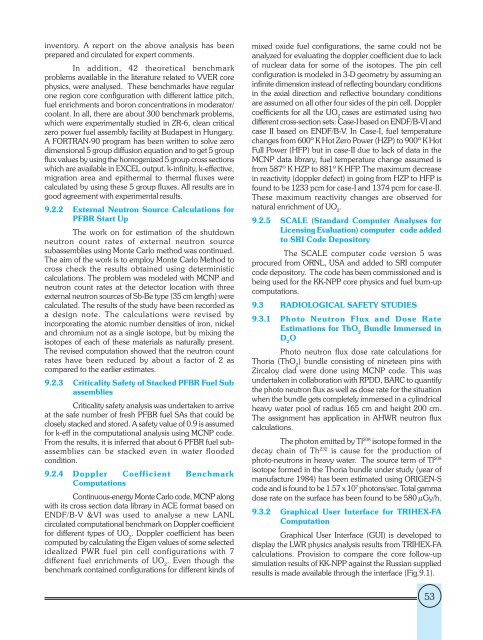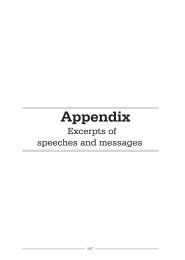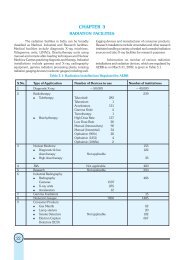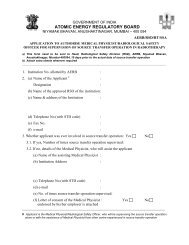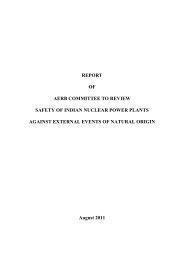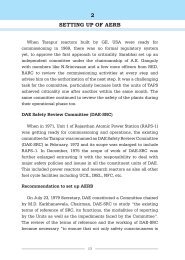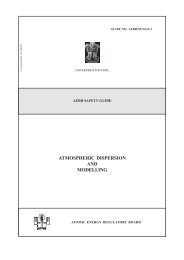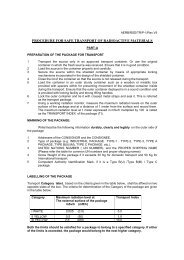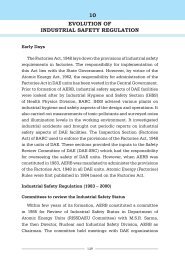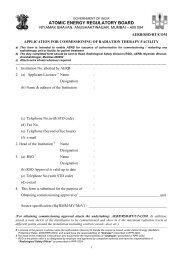here - Atomic Energy Regulatory Board
here - Atomic Energy Regulatory Board
here - Atomic Energy Regulatory Board
You also want an ePaper? Increase the reach of your titles
YUMPU automatically turns print PDFs into web optimized ePapers that Google loves.
inventory. A report on the above analysis has been<br />
prepared and circulated for expert comments.<br />
In addition, 42 theoretical benchmark<br />
problems available in the literature related to VVER core<br />
physics, were analysed. These benchmarks have regular<br />
one region core configuration with different lattice pitch,<br />
fuel enrichments and boron concentrations in moderator/<br />
coolant. In all, t<strong>here</strong> are about 300 benchmark problems,<br />
which were experimentally studied in ZR-6, clean critical<br />
zero power fuel assembly facility at Budapest in Hungary.<br />
A FORTRAN-90 program has been written to solve zero<br />
dimensional 5 group diffusion equation and to get 5 group<br />
flux values by using the homogenized 5 group cross sections<br />
which are available in EXCEL output. k-infinity, k-effective,<br />
migration area and epithermal to thermal fluxes were<br />
calculated by using these 5 group fluxes. All results are in<br />
good agreement with experimental results.<br />
9.2.2 External Neutron Source Calculations for<br />
PFBR Start Up<br />
The work on for estimation of the shutdown<br />
neutron count rates of external neutron source<br />
subassemblies using Monte Carlo method was continued.<br />
The aim of the work is to employ Monte Carlo Method to<br />
cross check the results obtained using deterministic<br />
calculations. The problem was modeled with MCNP and<br />
neutron count rates at the detector location with three<br />
external neutron sources of Sb-Be type (35 cm length) were<br />
calculated. The results of the study have been recorded as<br />
a design note. The calculations were revised by<br />
incorporating the atomic number densities of iron, nickel<br />
and chromium not as a single isotope, but by mixing the<br />
isotopes of each of these materials as naturally present.<br />
The revised computation showed that the neutron count<br />
rates have been reduced by about a factor of 2 as<br />
compared to the earlier estimates.<br />
9.2.3 Criticality Safety of Stacked PFBR Fuel Sub<br />
assemblies<br />
Criticality safety analysis was undertaken to arrive<br />
at the safe number of fresh PFBR fuel SAs that could be<br />
closely stacked and stored. A safety value of 0.9 is assumed<br />
for k-eff in the computational analysis using MCNP code.<br />
From the results, it is inferred that about 6 PFBR fuel subassemblies<br />
can be stacked even in water flooded<br />
condition.<br />
9.2.4 Doppler Coefficient Benchmark<br />
Computations<br />
Continuous-energy Monte Carlo code, MCNP along<br />
with its cross section data library in ACE format based on<br />
ENDF/B-V &VI was used to analyse a new LANL<br />
circulated computational benchmark on Doppler coefficient<br />
for different types of UO 2<br />
. Doppler coefficient has been<br />
computed by calculating the Eigen values of some selected<br />
idealized PWR fuel pin cell configurations with 7<br />
different fuel enrichments of UO 2<br />
. Even though the<br />
benchmark contained configurations for different kinds of<br />
mixed oxide fuel configurations, the same could not be<br />
analyzed for evaluating the doppler coefficient due to lack<br />
of nuclear data for some of the isotopes. The pin cell<br />
configuration is modeled in 3-D geometry by assuming an<br />
infinite dimension instead of reflecting boundary conditions<br />
in the axial direction and reflective boundary conditions<br />
are assumed on all other four sides of the pin cell. Doppler<br />
coefficients for all the UO 2<br />
cases are estimated using two<br />
different cross-section sets: Case-I based on ENDF/B-VI and<br />
case II based on ENDF/B-V. In Case-I, fuel temperature<br />
changes from 600º K Hot Zero Power (HZP) to 900º K Hot<br />
Full Power (HFP) but in case-II due to lack of data in the<br />
MCNP data library, fuel temperature change assumed is<br />
from 587º K HZP to 881º K HFP. The maximum decrease<br />
in reactivity (doppler defect) in going from HZP to HFP is<br />
found to be 1233 pcm for case-I and 1374 pcm for case-II.<br />
These maximum reactivity changes are observed for<br />
natural enrichment of UO 2<br />
.<br />
9.2.5 SCALE (Standard Computer Analyses for<br />
Licensing Evaluation) computer code added<br />
to SRI Code Depository<br />
The SCALE computer code version 5 was<br />
procured from ORNL, USA and added to SRI computer<br />
code depository. The code has been commissioned and is<br />
being used for the KK-NPP core physics and fuel burn-up<br />
computations.<br />
9.3 RADIOLOGICAL SAFETY STUDIES<br />
9.3.1 Photo Neutron Flux and Dose Rate<br />
Estimations for ThO 2<br />
Bundle Immersed in<br />
D 2<br />
O<br />
Photo neutron flux dose rate calculations for<br />
Thoria (ThO 2<br />
) bundle consisting of nineteen pins with<br />
Zircaloy clad were done using MCNP code. This was<br />
undertaken in collaboration with RPDD, BARC to quantify<br />
the photo neutron flux as well as dose rate for the situation<br />
when the bundle gets completely immersed in a cylindrical<br />
heavy water pool of radius 165 cm and height 200 cm.<br />
The assignment has application in AHWR neutron flux<br />
calculations.<br />
The photon emitted by Tl 208 isotope formed in the<br />
decay chain of Th 232 is cause for the production of<br />
photo-neutrons in heavy water. The source term of Tl 208<br />
isotope formed in the Thoria bundle under study (year of<br />
manufacture 1984) has been estimated using ORIGEN-S<br />
code and is found to be 1.57 x 10 7 photons/sec. Total gamma<br />
dose rate on the surface has been found to be 580 µGy/h.<br />
9.3.2 Graphical User Interface for TRIHEX-FA<br />
Computation<br />
Graphical User Interface (GUI) is developed to<br />
display the LWR physics analysis results from TRIHEX-FA<br />
calculations. Provision to compare the core follow-up<br />
simulation results of KK-NPP against the Russian supplied<br />
results is made available through the interface (Fig.9.1).<br />
53


